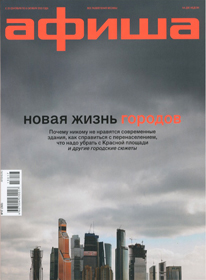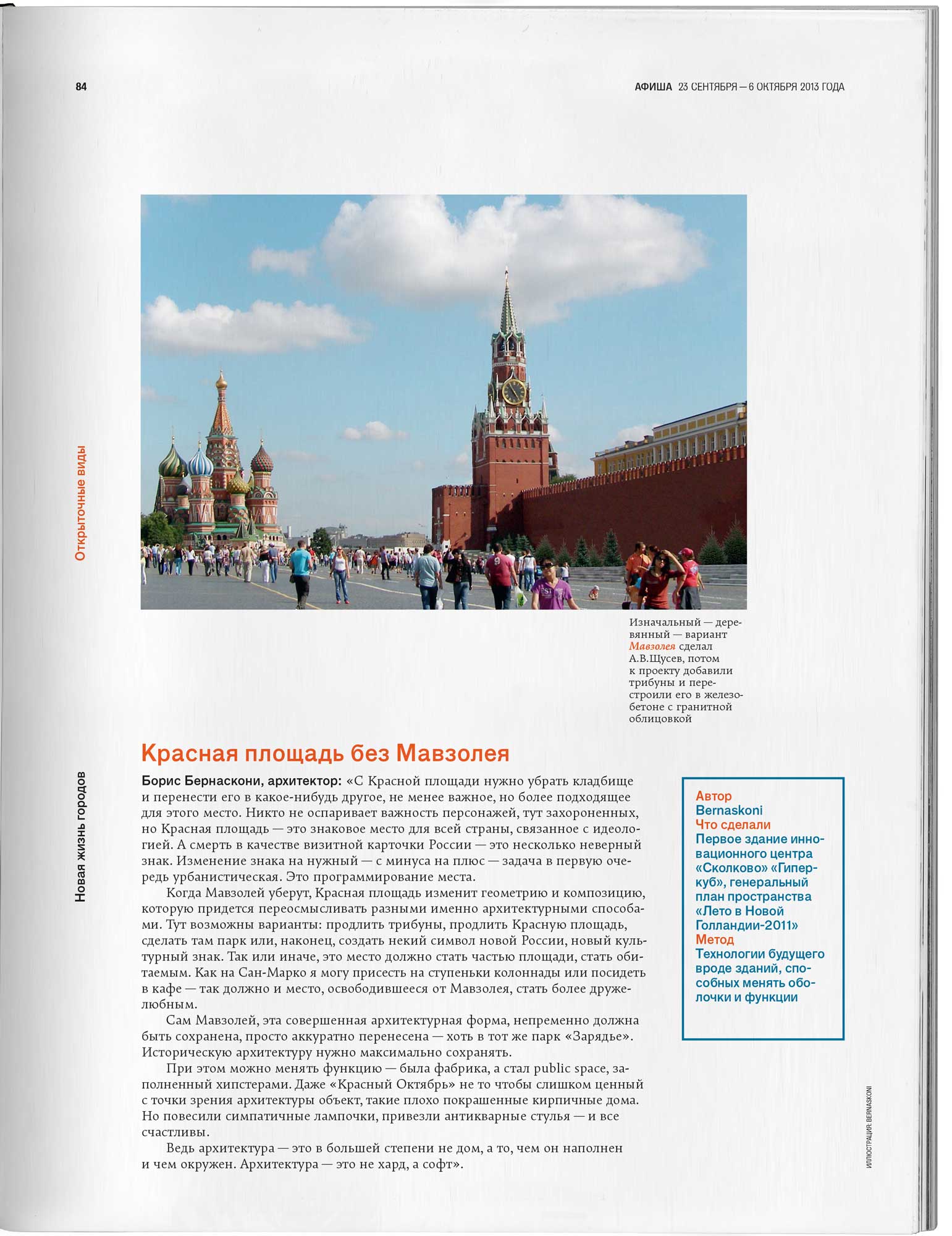
Сентябрь 2013September 2013

«Архитектура — это не хард, а софт»“ARCHITECTURE IS NOT HARDWARE, BUT SOFTWARE”
С Красной площади нужно убрать кладбище и перенести его в какое-нибудь другое, не менее важное, но более подходящее для этого место. Никто не оспаривает важность персонажей, тут захороненных, но Красная площадь — это знаковое место для всей страны, связанное с идеологией. А смерть в качестве визитной карточки России — это несколько неверный знак. Изменение знака на нужный — с минуса на плюс — задача в первую очередь урбанистическая. Это программирование места.
Когда Мавзолей уберут, Красная площадь изменит геометрию и композицию, которую придется переосмысливать разными именно архитектурными способами. Тут возможны варианты: продлить трибуны, продлить Красную площадь, сделать там парк или, наконец, создать некий символ новой России, новый культурный знак. Так или иначе, это место должно стать частью площади, стать обитаемым. Как на Сан-Марко я могу присесть на ступеньки колоннады или посидеть в кафе – так должно и место, освободившееся от Мавзолея, стать более дружелюбным.
Сам Мавзолей, эта совершенная архитектурная форма, непременно должна быть сохранена, просто аккуратно перенесена — хоть в тот же парк «Зарядье». Историческую архитектуру нужно максимально сохранять.
При этом можно менять функцию — была фабрика, а стал public space, заполненный хипстерами. Даже «Красный Октябрь» не то чтобы слишком ценный с точки зрения архитектуры объект, такие плохо покрашенные кирпичные дома. Но повесили симпатичные лампочки, привезли антикварные стулья — и все счастливы.
Ведь архитектура — это в большей степени не дом, а то, чем он наполнен и чем окружен. Архитектура — это не хард, а софт.
The necropolis should be removed from Red Square to some other, no less important, but far more suitable place. Nobody disputes the importance of the figures buried here, but Red Square is a landmark for the whole country, connected with ideology. And having death as Russia’s calling card is hardly the best kind of signal to be making. To change the sign appropriately – from a minus to a plus – is primarily a task of urbanistics. It’s about the programming of place.
When they take away the Mausoleum, Red Square will have a changed geometry and composition, which will have to be re-thought in various different ways by architectural means. Several options are possible here: to extend the tribunes, to extend the square itself, to lay out a park there, or, finally, to create a symbol for the new Russia, a new cultural sign. Whatever happens, the site should become part of the square, be made habitable. Just as you can sit on the steps of the colonnade or in a café on the Piazza San Marco – so should this area, once freed of the Mausoleum, become a much friendlier place.
The Mausoleum itself, that perfect architectural form, definitely ought to be preserved, just neatly transferred to another location – perhaps even in the nearby Zaryadye Park. Historical architecture should be preserved as much as possible.
At the same time, you might consider a change of function – like the former factories that are now public spaces filled with hipsters. The old Krasny Oktyabr chocolate factory isn’t even particularly valuable from an architectural point of view, being made up of such badly painted brick buildings. But they put up some pretty lamps, brought along some antique chairs – and everyone was happy.
Architecture is, after all, less about a house than about what fills it and surrounds it. Architecture is not hardware, but software.
